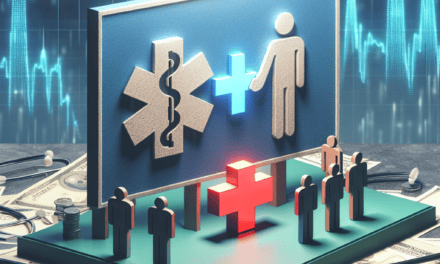AHA Urges Trump to Exempt Medical Devices from Import Tariffs
The American Hospital Association (AHA) has recently made headlines by urging the Trump administration to exempt medical devices from import tariffs. This call to action is rooted in the belief that such tariffs could have detrimental effects on healthcare delivery in the United States. As the healthcare landscape continues to evolve, understanding the implications of import tariffs on medical devices is crucial for stakeholders across the industry. This article delves into the various dimensions of this issue, exploring the rationale behind the AHA’s request, the potential impacts of tariffs, and the broader context of healthcare economics.
Understanding the AHA’s Position
The AHA represents thousands of hospitals and healthcare systems across the United States, advocating for policies that enhance patient care and improve healthcare delivery. The association’s recent push to exempt medical devices from import tariffs stems from several key concerns:
- Impact on Patient Care: The AHA argues that tariffs could lead to increased costs for medical devices, which may ultimately be passed on to patients. This could hinder access to essential medical technologies.
- Healthcare Costs: Rising costs associated with tariffs could exacerbate the already significant financial pressures faced by hospitals and healthcare providers.
- Innovation and Competition: Tariffs may stifle innovation in the medical device sector by increasing the financial burden on manufacturers, potentially leading to fewer advancements in technology.
- Global Supply Chains: The medical device industry relies heavily on global supply chains. Tariffs could disrupt these networks, leading to delays and shortages of critical equipment.
- Economic Considerations: The AHA emphasizes the need for a balanced approach that considers both economic growth and the well-being of patients.
By advocating for an exemption, the AHA aims to protect both healthcare providers and patients from the unintended consequences of trade policies that may not fully consider the unique dynamics of the healthcare sector.
The Economic Impact of Tariffs on Medical Devices
Import tariffs are taxes imposed on goods brought into a country, and they can significantly affect the pricing and availability of products. In the context of medical devices, the economic implications are multifaceted:
Firstly, tariffs can lead to increased costs for manufacturers. When tariffs are applied to imported components or finished devices, manufacturers may face higher production costs. This can result in:
- Increased Prices: Manufacturers may pass on these costs to healthcare providers, leading to higher prices for medical devices.
- Reduced Profit Margins: Companies may experience squeezed profit margins, which can limit their ability to invest in research and development.
- Job Losses: If companies are unable to absorb the costs, they may resort to layoffs or reduced hiring, impacting employment in the sector.
Moreover, the medical device industry is characterized by a high degree of innovation. Companies invest heavily in research and development to create cutting-edge technologies that improve patient outcomes. However, increased costs due to tariffs can divert funds away from innovation, leading to:
- Fewer New Products: Companies may delay or cancel the development of new devices, limiting options for healthcare providers.
- Stagnation in Technology: A slowdown in innovation can hinder advancements in medical technology, affecting patient care.
Additionally, the global nature of the medical device supply chain means that tariffs can disrupt established networks. Many medical devices are composed of components sourced from various countries. Tariffs can lead to:
- Supply Chain Disruptions: Increased costs may lead manufacturers to seek alternative suppliers, potentially resulting in delays and shortages.
- Quality Concerns: Switching suppliers may compromise the quality of components, impacting the safety and efficacy of medical devices.
In summary, the economic impact of tariffs on medical devices is profound, affecting everything from pricing and innovation to supply chain stability. The AHA’s call for exemption is rooted in a desire to mitigate these adverse effects and ensure that healthcare providers can continue to deliver high-quality care.
The Role of Medical Devices in Healthcare Delivery
Medical devices play a critical role in modern healthcare delivery, encompassing a wide range of products from simple bandages to complex imaging machines. Understanding their significance is essential in evaluating the potential impact of tariffs:
Medical devices are integral to:
- Diagnosis: Devices such as MRI machines, CT scanners, and ultrasound equipment are essential for accurate diagnosis and treatment planning.
- Treatment: Surgical instruments, implantable devices, and therapeutic equipment are vital for effective treatment and patient recovery.
- Monitoring: Devices like heart monitors and glucose meters enable continuous monitoring of patients’ health, facilitating timely interventions.
The reliance on medical devices is evident in various healthcare settings, including hospitals, outpatient clinics, and home care. For instance, consider the case of diabetes management:
Continuous glucose monitors (CGMs) have revolutionized diabetes care by providing real-time data on blood sugar levels. This technology allows patients to make informed decisions about their diet and medication, ultimately improving health outcomes. However, if tariffs lead to increased costs for CGMs, patients may face higher out-of-pocket expenses, potentially discouraging them from using these life-saving devices.
Furthermore, the COVID-19 pandemic has underscored the importance of medical devices in managing public health crises. Ventilators, personal protective equipment (PPE), and diagnostic tests have been critical in combating the virus. Tariffs on these essential items could hinder the ability of healthcare systems to respond effectively to future health emergencies.
In conclusion, medical devices are indispensable in healthcare delivery, and any disruption in their availability or affordability due to tariffs could have far-reaching consequences for patient care and public health.
Case Studies: The Impact of Tariffs on the Medical Device Industry
To better understand the implications of import tariffs on medical devices, examining specific case studies can provide valuable insights. Here are a few notable examples:
Case Study 1: The Impact of Tariffs on Imaging Equipment
Imaging equipment, such as MRI and CT machines, is essential for accurate diagnosis and treatment planning. In 2018, the Trump administration imposed tariffs on various medical devices, including imaging equipment sourced from China. The immediate effects were felt by manufacturers and healthcare providers alike:
- Increased Costs: Manufacturers reported a significant increase in production costs due to tariffs on imported components. This led to price hikes for hospitals purchasing imaging equipment.
- Delayed Purchases: Many hospitals postponed purchasing new imaging machines, opting to extend the life of existing equipment. This delay in upgrading technology can negatively impact patient care.
As a result, hospitals faced challenges in providing timely diagnoses, which can be critical in conditions such as cancer or stroke. The case of imaging equipment illustrates how tariffs can create a ripple effect throughout the healthcare system.
Case Study 2: The Effect on Surgical Instruments
Surgical instruments are another critical category of medical devices that have been affected by tariffs. In 2019, tariffs were imposed on surgical instruments imported from various countries, including China. The consequences were significant:
- Increased Surgical Costs: Hospitals reported rising costs for surgical instruments, leading to higher overall surgical expenses. This could result in increased patient bills and insurance premiums.
- Impact on Surgical Schedules: Some hospitals faced delays in surgeries due to shortages of specific instruments, affecting patient outcomes and hospital efficiency.
This case study highlights how tariffs can disrupt the availability of essential surgical tools, ultimately impacting patient care and hospital operations.
Case Study 3: The Role of Innovation in Medical Devices
The medical device industry is characterized by rapid innovation, with companies constantly developing new technologies to improve patient outcomes. However, tariffs can stifle this innovation. For example:
- Investment Cuts: Companies facing increased costs due to tariffs may cut back on research and development budgets, leading to fewer new products entering the market.
- Market Consolidation: Smaller companies may struggle to compete with larger manufacturers that can absorb tariff costs, leading to market consolidation and reduced competition.
This case study underscores the importance of maintaining a favorable economic environment for innovation in the medical device sector. Without it, patients may miss out on groundbreaking technologies that could enhance their care.
Policy Considerations and Future Implications
The AHA’s call for an exemption from import tariffs on medical devices raises important policy considerations. As policymakers navigate the complexities of trade and healthcare, several factors must be taken into account:
- Balancing Trade and Healthcare: Policymakers must find a balance between protecting domestic industries and ensuring that healthcare providers have access to affordable medical devices.
- Long-Term Economic Impact: The long-term economic implications of tariffs on healthcare delivery should be carefully evaluated, considering both immediate and future consequences.
- Stakeholder Engagement: Engaging stakeholders from the healthcare sector, including hospitals, manufacturers, and patients, is essential in shaping effective trade policies.
- Global Collaboration: Collaborating with international partners to address trade issues while safeguarding healthcare access is crucial in an interconnected world.
As the healthcare landscape continues to evolve, the implications of import tariffs on medical devices will remain a critical topic of discussion. Policymakers must consider the unique dynamics of the healthcare sector and prioritize patient care in their decision-making processes.
Conclusion: The Path Forward
The AHA’s urgent plea for the exemption of medical devices from import tariffs highlights the complex interplay between trade policy and healthcare delivery. As this issue unfolds, it is essential to recognize the potential consequences of tariffs on patient care, innovation, and the overall healthcare system.
Key takeaways from this discussion include:
- The economic impact of tariffs on medical devices can lead to increased costs, reduced innovation, and supply chain disruptions.
- Medical devices are integral to healthcare delivery, and any barriers to their availability can adversely affect patient outcomes.
- Case studies illustrate the real-world implications of tariffs on specific categories of medical devices, emphasizing the need for careful policy consideration.
- Future policy decisions must balance trade interests with the imperative of ensuring access to affordable medical technologies for healthcare providers and patients.
In conclusion, as stakeholders in the healthcare industry advocate for policies that prioritize patient care, it is crucial to remain vigilant about the potential impacts of trade policies on the medical device sector. The path forward requires collaboration, innovation, and a commitment to safeguarding the health and well-being of all Americans.





